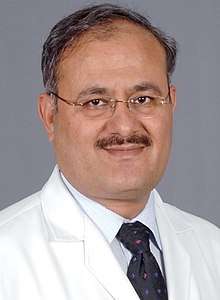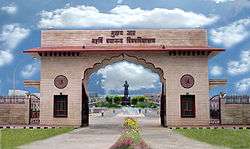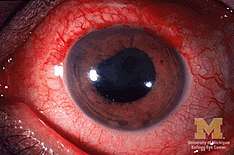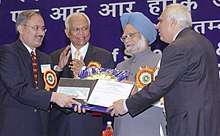V. S. Sangwan
Virender Singh Sangwan (born 22 August 1964) is an Indian ophthalmologist and the Dr. Paul Dubord Chair professor and director of the L. V. Prasad Eye Institute, Hyderabad. Known for his research on limbal stem cells, Sangwan is the founder secretary and an adviser of the Uveitis Society of India. The Council of Scientific and Industrial Research, the apex agency of the Government of India for scientific research, awarded him the Shanti Swarup Bhatnagar Prize for Science and Technology, one of the highest Indian science awards for his contributions to Medical Sciences in 2006.[1][note 1]
V. S. Sangwan | |
|---|---|
 | |
| Born | 22 August 1964 Haryana, India |
| Nationality | Indian |
| Alma mater | |
| Known for | Studies on limbal stem cell biology |
| Awards | |
| Scientific career | |
| Fields | |
| Institutions | |
Biography

Born in the north Indian state of Haryana, Virender S. Sangwan graduated in medicine from Maharshi Dayanand University in 1986 and completed his MS in ophthalmology in 1991.[2] Subsequently, he did a fellowship at L. V. Prasad Eye Institute (LVPEI) on cornea and anterior segment surgery and during his stay there, Gullapalli Nageswara Rao, the founder of the institute, advised him about the opportunity to join Orbis International as an acting medical director at Orbis Flying Eye Hospital which he accepted.[3] He held the position for over 18 months and left for another fellowship program on ocular immunology and uveitis at Massachusetts Eye and Ear, an associate of Harvard Medical School under the supervision of Charles Stephen Foster, who would later found the Massachusetts Eye Research and Surgery Institution.[4] Returning to India, he re-joined LVPEI as a cornea specialist, became an associate director[5] and a director[6] and heads SRUJANA Centre for Innovation[7] as well as the Center for Ocular Regeneration, a joint venture of LVPEI and Massachusetts Institute of Technology.[8] He holds the Dr.Paul Dubord Chair in Cornea at LVPEI[9] and is as an adjunct associate professor at University of Rochester.[10]
Virender Sangwan is married to Vandana who is a dental surgeon and the couple has two children, Sonalika and Sahil.[10]
Legacy

Sangwan has done extensive work on limbal stem cells which is reported to have assisted in restoring vision to patients with corneal injuries.[11] Along with Geeta K. Vemuganti, an ophthalmologist with interest in limbal stem cell studies, he carried out research on the subject and together they developed a methodology for growing stem cells for subsequent transplantation in human eyes for repairing injured epithelium and cornea.[12] This was subsequently put on clinical trial in 2011,[3] reported to be the largest successful trial of stem cell therapy on humans, till then.[10][13] Later, with the assistance of two philanthropists, they established Sudhakar and Sreekanth Ravi Stem Cell Biology Laboratory where he furthered his work. The methodology developed by him involved harvesting of cell tissues from the healthy eye of the patient and cultivation of the cell tissues on amniotic sac membrane which was then transplanted on the injured eye; he has done over 800 transplants at LVPEI, reportedly with 76% success rate.[14] Later, he also developed a methodology for culturing conjunctival and limbal stem cells together which is known to have application in treating patients with extreme ocular damage of the outer surface.[5] His studies have been documented by way of a number of articles[15][note 2] of which many have been listed by online article repositories such as Google Scholar[16] and ResearchGate,[17] and his work has drawn citations in texts by others.[18][19][20] He has also served as an investigator in a number of clinical projects undertaken by Sudhakar and Sreekanth Ravi Stem Cell Biology Laboratory.[21]
Sangwan, having undergone two years' of training at Foster's laboratory on ocular immunology, had started his Indian career focusing on ocular inflammatory diseases such as Uveitis and his early work was in this field was as an uveitis and retina specialist at LVPEI.[3] This gave him the opportunity to interact with the pioneers of uveitis treatment in India such as Narsing A. Rao, Amod Gupta, Rajeeve Buddi, Jyotirmay Biswas and S. R. Rathinam and when Rao inspired the others to form the Uveitis Society of India in 1999, he was among the founder members, serving as its founder secretary and treasurer,[22] where he is a member of the advisory board of the society.[23] He is involved with the Himalayan Vision Project, a joint venture between LV Prasad Eye Institute and Himalayan Health Project[2] and has been associated with journals including Indian Journal of Ophthalmology, Comprehensive Ophthalmology Update, Clinical & Experimental Ophthalmology, International Ophthalmology and British Journal of Ophthalmology. A vice president of the Asia Cornea Society,[24] he is an honorary member of North African Centre for Sight and Visual Sciences as well as the national societies of ophthalmology of Peru and El Salvador. He sat in the international steering committees of Lux Uveitis Multicenter Investigation of a New Approach to Treatment (LUMINATE) trial and LUCIDA Program for Prevention of Corneal Transplant Rejection of Lux Biosciences and is a former secretary of Eye Bank Association of India.[10] The invited speeches or keynote addresses delivered by him include a lecture on Cell-based Therapy for Ocular Reconstruction at the Louis J. Fox Center for Vision Restoration of University of Pittsburgh Medical Center in October 2010.[25] and the TEDx talk titled, Square Peg in Round Hole at National Institute of Technology Calicut on 14 January 2012.[26]
Awards and honors

Sangwan received the Dr. P. Siva Reddy Researcher of the Year Award of the Andhra Pradesh Akademi of Sciences in 2002 and two of his papers won the Dr. Vengal Rao Award of Andhra Pradesh Ophthalmic Society and Col. Rangachary Award of the All India Ophthalmology Society in 2003 and 2005 respectively.[10] The Council of Scientific and Industrial Research awarded him Shanti Swarup Bhatnagar Prize, one of the highest Indian science awards in 2006.[27] and he received the National Technology Award of the Department of Biotechnology in 2007.[5] He is also a recipient of Achievement Award of the American Academy of Ophthalmology and Fortune magazine published a report on the stem cell research of Sangwan in its October 2007 issue.[10]
Selected bibliography
- M.S Sridhar, Aashish K Bansal, Virender S Sangwan, Gullapalli N Rao (2000). "Amniotic membrane transplantation in acute chemical and thermal injury". American Journal of Ophthalmology. 130 (1): 134–137. doi:10.1016/S0002-9394(00)00500-6. PMID 11004281.CS1 maint: multiple names: authors list (link)
- Fernandes, Merle; Sridhar, Mittanamalli S; Sangwan, Virender S, Rao, Gullapalli N (2005). "Amniotic Membrane Transplantation for Ocular Surface Reconstruction". Cornea. 24 (6): 643–653. doi:10.1097/01.ico.0000151501.80952.c5. PMID 16015081.CS1 maint: multiple names: authors list (link)
- Virender S. Sangwan, Himanshu P. Matalia, Geeta K. Vemuganti, Ghazala Ifthekar, Anees Fatima, Shashi Singh, Gullapalli N. Rao (2005). "Early Results of Penetrating Keratoplasty After Cultivated Limbal Epithelium Transplantation". Arch. Ophthalmol. 123 (3): 334–340. doi:10.1001/archopht.123.3.334. PMID 15767475.CS1 maint: multiple names: authors list (link)
- Indumathi Mariappan, Savitri Maddileti, Soumya Savy, Shubha Tiwari, Subhash Gaddipati, Anees Fatima, Virender S Sangwan, Dorairajan Balasubramanian, Geeta K Vemuganti (2010). "In vitro culture and expansion of human limbal epithelial cells". Nature Protocols. 5 (8): 1470–1479. doi:10.1038/nprot.2010.115. PMID 20671730.CS1 maint: multiple names: authors list (link)
- Virender S Sangwan, Rajat Jain, Sayan Basu, Anupam B Bagadi, Shraddha Sureka, Indumathi Mariappan, Sheila MacNeil (2014). "Transforming ocular surface stem cell research into successful clinical practice". Indian Journal of Ophthalmology. 62 (1): 29–40. doi:10.4103/0301-4738.126173. PMC 3955067. PMID 24492499.CS1 maint: multiple names: authors list (link)
Notes
- Long link – please select award year to see details
- Please see Selected bibliography section
References
- "View Bhatnagar Awardees". Shanti Swarup Bhatnagar Prize. 2016. Archived from the original on 16 October 2016. Retrieved 12 November 2016.
- "Dr Virender Sangwan on HVP". Himalayan Vision Project. 2017. Archived from the original on 1 April 2017.
- "Pioneer gives hope to neglected surface disease patients". Healio. September 2008. Archived from the original on 1 April 2017.
- "About Dr. Foster". Uveitis.org. 2017. Archived from the original on 6 October 2016.
- "Biography on Orcid". Orcid. 2017. Archived from the original on 1 April 2017.
- "Key People". L. V. Prasad Eye Institute. 2017. Archived from the original on 17 January 2015. Retrieved 31 March 2017.
- "Our Team – Virender Singh Sangwan". L. V. Prasad Eye Institute. 2017. Archived from the original on 13 October 2016. Retrieved 31 March 2017.
- "The people who make this possible". LVPEI Mitra. 2017. Archived from the original on 5 November 2016.
- "RG Info". ResearchGate. 2017. Archived from the original on 1 April 2017.
- "Virender Sangwan on INK Talks". INK Talks. 2017. Archived from the original on 1 July 2016.
- "Brief Profile of the Awardee". Shanti Swarup Bhatnagar Prize. 2017. Archived from the original on 1 April 2017.
- "Directors". LVP Mitra. 2017. Archived from the original on 5 November 2016.
- "Eye of the Stem Cell". India Today. 10 September 2011. Archived from the original on 11 September 2016.
- "Eye of the Stem Cell: Virender Singh Sangwan". India Today. 10 September 2011. Archived from the original on 11 September 2016.
- "Sangwan VS [au]". US National Library of Medicine. 2017. p. List of articles on PubMed. Archived from the original on 3 April 2017.
- "On Google Scholar". Google Scholar. 2017. Archived from the original on 1 April 2017.
- "On ResearchGate". On ResearchGate. 2017. Archived from the original on 1 July 2016.
- Kwang W. Jeon (16 November 2015). International Review of Cell and Molecular Biology. Elsevier Science. pp. 102–. ISBN 978-0-12-802476-8. Archived from the original on 1 April 2017.
- TALWAR, G.P. (2015). TEXTBOOK OF BIOCHEMISTRY, BIOTECHNOLOGY, ALLIED AND MOLECULAR MEDICINE. PHI Learning Pvt. Ltd. pp. 475–. ISBN 978-81-203-5125-7. Archived from the original on 1 April 2017.
- Raul Martin Herranz; Rosa M. Corrales Herran (18 October 2012). Ocular Surface: Anatomy and Physiology, Disorders and Therapeutic Care. CRC Press. pp. 226–. ISBN 978-1-57808-740-2. Archived from the original on 1 April 2017.
- "Current Projects". Sudhakar and Sreekanth Ravi Stem Cell Biology Laboratory. 2017. Archived from the original on 1 April 2017.
- "History". Uveitis Society of India. 2017. Archived from the original on 1 April 2017.
- "Executive Team". Uveitis Society of India. 2017. Archived from the original on 1 April 2017.
- "Vice president". Asia Cornea Society. 2017. Archived from the original on 2 June 2016.
- "Cell-based Therapy for Ocular Reconstruction". Louis J. Fox Center for Vision Restoration. 15 October 2010. Archived from the original on 1 April 2017.
- "TEDxNITCalicut – Dr Virender Singh Sangwan – Square Peg in Round Hole". TEDx Talks. 15 March 2012. Archived from the original on 22 July 2014.
- "Medical Sciences". Council of Scientific and Industrial Research. 2017. Archived from the original on 24 February 2013.
External links
- "Profile of Top 25 scientists in India". India Today. 11 September 2011. Retrieved 17 January 2018.